Topic: Solar System Data
Solar System Data
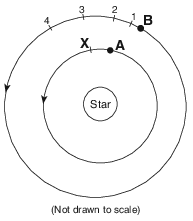
If the diagram represents our solar system and planet B is Venus, which planet is represented by planet A?
(1) Mercury
(2) Jupiter
(3) Earth
(4) Mars
The universe is approximately 13.8 billion years old. Compared to the age of the solar system, the age of the universe is approximately
(1) the same age as the solar system
(2) two times older than the solar system
(3) three times older than the solar system
(4) four times older than the solar system
Which motion occurs at a rate of approximately one degree per day?
(1) the Moon revolving around Earth
(2) the Moon rotating on its axis
(3) Earth revolving around the Sun
(4) Earth rotating on its axis
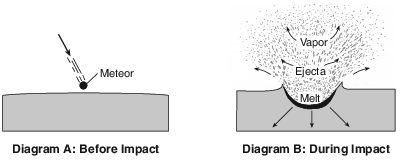
Many meteors are believed to be fragments of celestial objects normally found between the orbits of Mars and Jupiter. These objects are classified as
(1) stars
(2) asteroids
(3) planets
(4) moons
The diagram below compares the relative diameters of two planets in our solar system.

Which two planets have diameters that most closely resemble this comparison?
(1) Uranus and Neptune
(2) Jupiter and Saturn
(3) Earth and Mars
(4) Mercury and Venus
The terrestrial planets differ from the Jovian planets because the terrestrial planets are
(1) less dense and larger
(2) less dense and smaller
(3) more dense and larger
(4) more dense and smaller
Compared to terrestrial planets, Jovian planets have
(1) smaller equatorial diameters and shorter periods of revolution
(2) smaller equatorial diameters and longer periods of revolution
(3) larger equatorial diameters and shorter periods of revolution
(4) larger equatorial diameters and longer periods of revolution
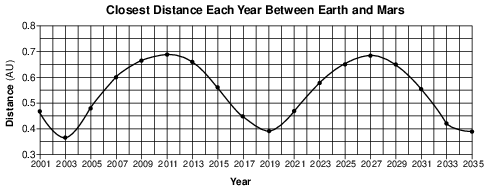
How many million kilometers is one astronomical unit?
(1) 108.2 million km
(2) 149.6 million km
(3) 227.9 million km
(4) 377.5 million km
Planets that are closest to the Sun are identified as
(1) low-density Jovian
(2) low-density terrestrial
(3) high-density Jovian
(4) high-density terrestrial

In image below, circle the type of planet (terrestrial or Jovian) to indicate the classification of the three solar system planets shown in the diagram. Describe one characteristic of this type of planet that distinguishes it from the other type of planet. [1]
Circle one: terrestrial planet Jovian planet Characteristic of this type of planet:
Allow 1 credit if both terrestrial planet is circled and an acceptable characteristic is described.. Acceptable responses include, but are not limited to:
• — smaller diameter than Jovian
• — higher density
• — Terrestrial planet densities range from 3.9 g/cm3 to 5.5 g/cm3.
• — rocky/solid
• — not gaseous
• — closer to the Sun
• — less mass
• — shorter period of revolution
• — longer periods of rotation
• — Terrestrial planets don’t have rings.
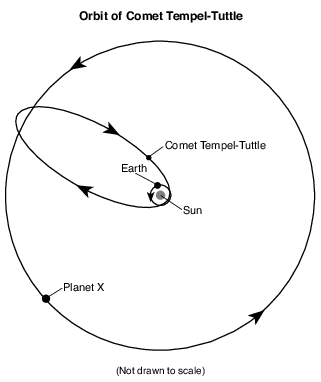
Comet Tempel-Tuttle
Comet Tempel-Tuttle orbits our Sun and is responsible for the Leonid meteor shower event observed from Earth. This meteor shower occurs every year in November and is visible in the night sky as Earth passes through the debris left in space by this comet. The debris from the comet produces meteors that are smaller than a grain of sand, which enter Earth’s atmosphere and burn up in the mesosphere temperature zone. Comet Tempel-Tuttle’s orbital distance from the Sun ranges from about 145 million kilometers at its closest approach to 2900 million kilometers at its farthest distance. Its two most recent closest approaches to the Sun occurred in 1965 and one revolution later in 1998.
Identify the solar system planet represented by planet X, which orbits near Comet Tempel-Tuttle’s farthest distance from the Sun. [1]
Allow 1 credit for Uranus.
Describe the actual shape of the Moon’s orbit. [1]
Allow 1 credit. Acceptable responses include, but are not limited to:
• — The Moon’s orbit has an elliptical shape.
• — slightly eccentric
• — almost a circle/nearly circular
• — oval
• — has an eccentricity of 0.055
• Note: Do not allow credit for “circle” or “circular” alone because the eccentricity of the Moon’s
• orbit is not zero.
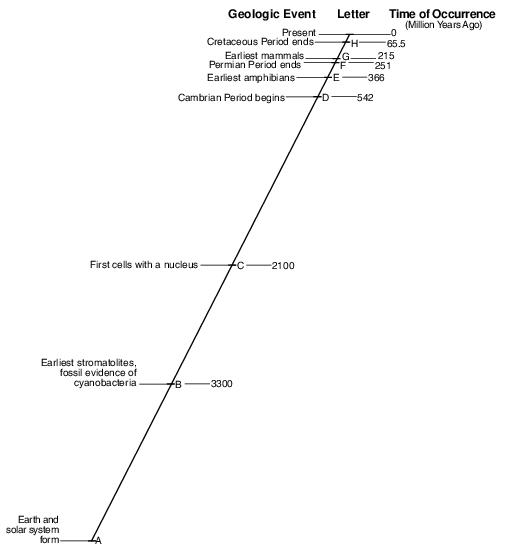
State the time of occurrence for the geologic event labeled A on the geologic timeline. [1]
______________ million years ago
Allow 1 credit. Acceptable responses include, but are not limited to:
• — 4600 million years ago
• — 4.6 × 103 million years ago
• Note: If the student crosses out million years ago, allow credit if an equivalent value is expressed
• in other units (e.g., 4.6 billion years ago).

The meteor impact debris was deposited at the time trilobites became extinct. State the age, in million years, of this debris layer. [1]
million years
Allow 1 credit for 251 million years.
In image below, place an X on the graph to indicate where Neptune would be plotted, based on its mean distance from the Sun and its equatorial diameter. [1]

Allow 1 credit if the center of the X for Neptune is plotted within or touches the grid square that is circled as shown below.
• Note: Allow credit if a symbol other than an X is used. Neptune need not be labeled.
• 
